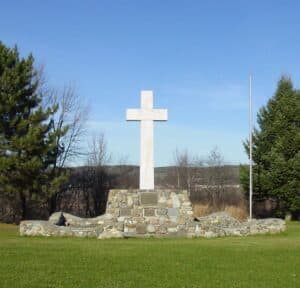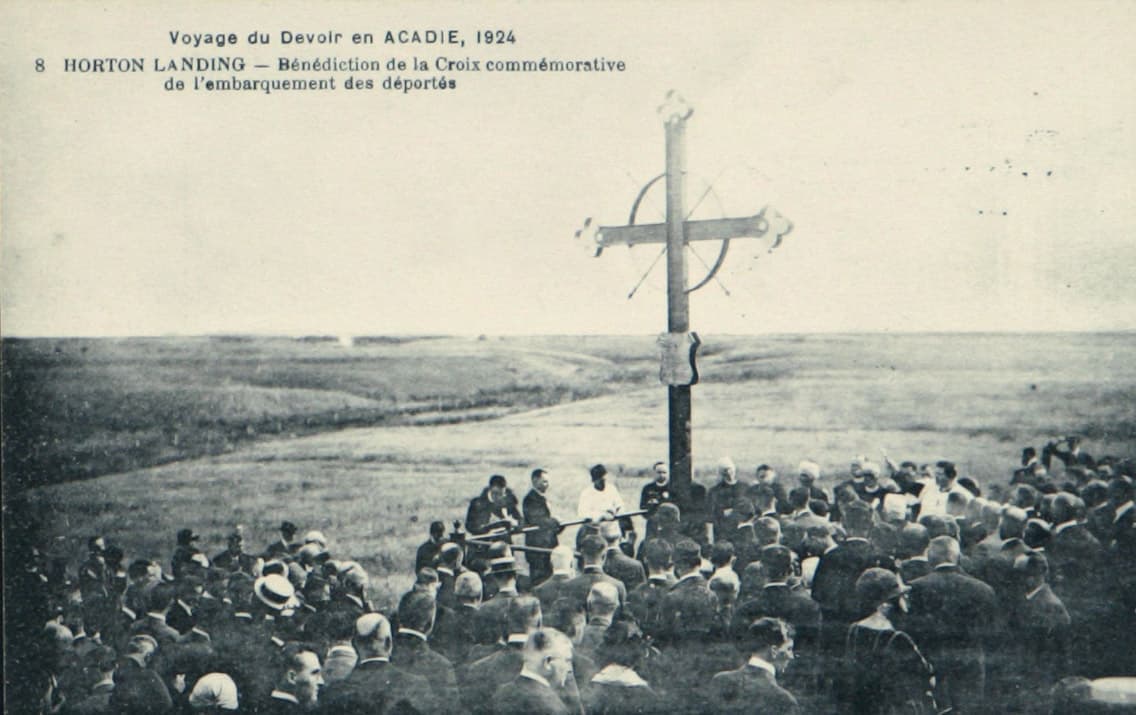On July 3, 1922, the Catholics of St. David, Maine, and surrounding communities gathered for an imposing and unprecedented ceremony on the banks of the St. John River. After a church service and addresses from religious dignitaries, Bishop Louis S. Walsh of Portland led a procession to a giant cross that awaited his blessing. The cross marked the location where, in 1785, Acadians had—according to local tradition—begun to form new communities after thirty years of tragedy and uncertainty. It seemed the Acadians were finally having their day in the sun.
Catholic and French
Walsh, an Irish American, may seem an unlikely player in this cultural pageant. Historical works portray him as Maine Franco-Americans’ ultimate bête noire. From 1909 to 1913, he was engaged in a lengthy conflict over the ownership and management of Church property in the diocese. Franco-Americans’ campaign to restore elective parish councils ultimately ended in failure. Walsh even placed a small group of activists under interdict, preventing them from receiving sacraments. The controversy ended with bruised and bitter feelings on both sides.
By the early 1920s, it was clear that Walsh and Franco-Americans needed one another. Tentative partnerships were not merely the result of Franco-Americans’ growing integration and the intervening cooling-off period. The Ku Klux Klan spread across the state and posed a threat to all Catholics; the Irish and French populations would benefit from working together. Walsh and Maine Catholics—including Franco-Americans—also expressed concern about growing federal and state intervention in education and healthcare. They formed a common political front.
The battle with the most enduring consequences occurred over the implementation of English-only education in public schools, a bill passed by the state legislature in 1919. Former legislator Irénée Cyr brought a lengthy petition signed by St. John Valley residents to Augusta—in vain. It remains unclear whether Walsh sincerely supported the French population of the Valley in their defense of their language—or simply disapproved of state overreach. Either way, Maine’s French population now recognized that the biggest threat to their culture came from beyond the Catholic Church.
Faced with recurring waves of xenophobia, it is little wonder that Walsh wished to assert the deep historical roots of the Church in Maine. He did so in commemorative ceremonies in August and in October 1913. The second of these was held at the city hall in Portland and put a Franco-American speaker front and center. Both events marked 300 years since the founding of the first Catholic mission in what would become Maine. The consecration of the Acadian Cross in the Madawaska region nearly a decade later served a similar purpose.

The rhetoric of that time depicted the original Indigenous inhabitants of the land as a population destined to be civilized or erased. As a result, major ceremonies identified French settlers as the first to occupy the land. In St. David and elsewhere, Walsh presented Catholics as full-fledged participants in the building of the country. People of Acadian and French-Canadian descent gladly showed their “Yankee” neighbors that they had preceded them in many parts of the continent. Precedence seemed to confer legitimacy.
Although the ceremony was led by an Irish-American bishop, this was a day by and for French-heritage people. The event drew L.-N. Dugal, the vicar general of the diocese of Chatham, in New Brunswick, and a pastor from Lewiston. Local French children received the sacrament of confirmation. Father Thomas Albert, author of a recent work of history, delivered a sermon in French.
As the epigraph above shows, in the wake of the event, the Bangor Daily News gave space to the Acadian story. Subscribers learned about the persecution wrought by the English Puritans, whom the author deemed guilty for the “crime” of deportation. References to these wandering people, escaping captivity to finding new, permanent homes, hinted at a providential destiny—if not something entirely Biblical.
This public recognition of the Acadians’ trials and resilience was not an isolated event; other developments offered signs of hope. In eastern Canada, the late-nineteenth-century Acadian Renaissance had led to interprovincial conventions and inspired elites to adopt new symbols. A month after the St. David ceremony, the first Acadian bishop, Edouard LeBlanc, blessed the cornerstone of what would become the iconic church at Grand-Pré, in Nova Scotia. Acadians had long occupied positions of political influence; their visibility as a people would grow later in the decade with the silent movie Evangeline. Cultural challenges would still abound, but recognition of their unique identity and their place in Maine history was finally at hand.
History and Commemoration
The St. David ceremony and the subsequent newspaper report told an Acadian story. To this day, so does the monument. Closer scrutiny of the people it honors offers a more complicated picture, however, and reminds us of the monument’s double meaning.
A plaque (much more recent than the cross) bears the names of the 35 “pioneers” of 1785. With the exception of Pierre Duperré, all are couples that had their own households. Not appearing on the plaque are these people’s children, many of whom would marry and intermarry in Saint-Basile after the establishment of the parish in 1792. Counting these children, we’re nearing some 100 individuals who might be considered original French-heritage settlers in our region.
French heritage may in fact be the better term for them, for by no means were they all Acadians. Brothers Firmin and Pierre Cyr married sisters Marie Josephte and Madeleine Ayotte. The Ayottes’ parents also appear on the monument; their whole family was French-Canadian. Other names originate from the St. Lawrence River valley and therefore are not Acadian: Guerrette dit Dumont, Bélanger, Lefebvre, Fournier, Potvin, and Consigny dit Sansfaçon. Nearly all of these families resided in the Kamouraska area when they were joined by Acadian refugees in the 1750s and 1760s. The meeting of Cyrs, Daigles, and Thibodeaus, and French-Canadian families anticipated the eventual cultural fusion of these two peoples in the Upper St. John Valley.

Acadians married French Canadians in Kamouraska but few stayed permanently. Some of these “mixed” households were enumerated on the St. John River near present-day Fredericton in the early 1780s. The influx of Loyalists and the challenge of securing land titles after 1783 led these families to seek a more stable future elsewhere. The Upper St. John River was a natural option as the midway point between the St. Lawrence and Fredericton; this also happened to be a river route that many had traveled and that promised trade between Quebec City and the eastern colonies. Officials in Quebec and New Brunswick were planning a military road connecting the two colonies and a settlement on the Upper St. John River would help guard that road.
We know the events of the summer of 1785 only through context, limited documentation produced by outside officials, and oral traditions. At the very least, we should not imagine a large convoy of families moving upriver from Fredericton with all of their personal belongings. The work of many summers was needed to turn forests into productive land. Settlers would spend the first season chopping trees. They would plant turnips and potatoes between the stumps, which might in time be burnt or pulled out once oxen and horses were available. Only then could fields be sown and plowed as they were elsewhere—and thus feed growing families.
In fact, whole families likely would not have come without some assurance that they held legal title to these lands, which they received in 1785. Beyond the small Indigenous village near Petit-Sault, a traveler passing through the region in September 1785 might have spied no more than a small riverside camp composed entirely of men—maybe in the shadow of a cross, and maybe not. The development of stable, enduring agricultural communities would take years and would be the joint work of Acadians and French Canadians.
By the time Bishop Walsh stepped down from the train with his clerical entourage, those communities’ survival was no longer in doubt. In fact, we could argue that the 1922 ceremony marked an important turning point in the region’s history. It looked back to the sacrifices of the original pioneers while responding to new challenges surrounding language and culture. The cross in St. David calls us to remember the men and women whose names appear on the base of the monument; it should also remind us of the struggles of the 1920s, when the cross was planted, many of which are still with us today.
The Madawaska Historical Society will recognize the centennial of the Acadian Cross during its annual luncheon on June 26.
Sources
Older, antiquarian works like Charles W. Collins’s The Acadians of Madawaska, Maine (1902) and Thomas Albert’s Histoire du Madawaska (1920) were standards for much of the twentieth century. Historians have since expanded our understanding of the region and its development. Sources for this essay include:
- Andrew, Sheila, “Mercure, Louis,” Dictionary of Canadian Biography, Vol. 5 (1983), online: http://www.biographi.ca/en/bio/mercure_louis_5E.html (accessed May 31, 2022).
- “La bénédiction de l’église de Grand-Pré,” Le Droit [Ottawa], August 16, 1922, 1.
- “Commemorating the Coming of the Acadians,” Bangor Daily News, July 7, 1922, 2.
- Craig, Béatrice, “Immigrants in a Frontier Community, Madawaska 1785-1850,” Revue de la Société historique du Madawaska (April 2008).
- Craig, Béatrice, Maxime Dagenais, Lisa Ornstein, and Guy Dubay, The Land in Between: The Upper St. John Valley, Prehistory to World War I (Gardiner: Tilbury House, 2009).
- “L’église-souvenir de Grand Pré,” La Tribune [Sherbrooke], February 18, 1922, 10.
- Lacroix, Patrick, “À l’assaut de la corporation sole: Autonomie institutionnelle et financière chez les Franco-Américains du Maine, 1900-1917,” Revue d’histoire de l’Amérique française, vol. 72, no. 1 (summer 2018), 31-51.
- Lacroix, Patrick, “Hauntingly Silent: Some Questions Concerning Maine’s English Education Bill,” Le Forum, vol. 43, no. 1 (spring 2021), 24-27.
- Richard, Mark Paul, Not a Catholic Nation: The Ku Klux Klan Confronts New England in the 1920s (Amherst: University of Massachusetts Press, 2015).
- “Le Tri-Centenaire Catholique,” La Justice [Biddeford], October 16, 1913, 2.
The Acadian Cross’s National Historic Register form appears online. Reliable information about the original French-heritage families is accessible at no cost on WikiTree. The Studholm Report of 1783 is also an essential source.
The Acadian Archives are home to a vast array of resources on the St. John Valley’s Acadian and French-Canadian settlers. For additional information or to schedule an appointment, please reach us at acadian@maine.edu or by phone at 207-834-7535.
